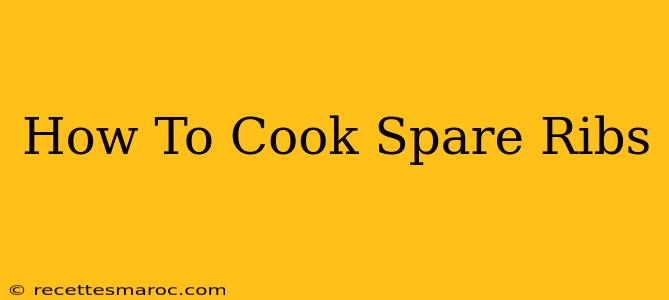Spare ribs, with their succulent meat and rich flavor, are a barbecue favorite. But achieving that perfect, fall-off-the-bone tenderness requires a bit of know-how. This guide will walk you through several methods for cooking spare ribs, ensuring you achieve juicy, delicious results every time.
Choosing Your Ribs
Before you even start cooking, selecting the right rack of spare ribs is crucial. Look for ribs that are:
- Heavy and meaty: A heavier rack generally indicates more meat.
- Bright red in color: This suggests freshness.
- With a good amount of marbling: Marbling contributes to flavor and tenderness.
Preparing the Ribs
Regardless of your chosen cooking method, proper preparation is key. This involves:
- Removing the membrane: The thin membrane on the back of the ribs can prevent them from becoming tender. Use a butter knife or your fingers to carefully peel it away. This is an essential step!
- Trimming excess fat: While some fat is good, trimming away large chunks of excess fat will help prevent overly greasy ribs.
Cooking Methods: Finding Your Perfect Rib
There are several ways to cook spare ribs, each offering a unique flavor profile and texture. Let's explore some popular methods:
1. 3-2-1 Ribs (Oven & Smoker Method):
This popular method combines oven roasting, smoking, and wrapping for maximum tenderness and flavor.
- 3 Hours: Ribs are smoked at 225°F (107°C) uncovered.
- 2 Hours: Ribs are wrapped in foil with a little liquid (apple juice, broth, or your favorite BBQ sauce). This allows the meat to steam and become incredibly tender.
- 1 Hour: Ribs are unwrapped, basted with BBQ sauce, and returned to the smoker to crisp up the bark.
This method delivers incredibly tender ribs with a beautiful bark.
2. Slow Cooker Ribs:
For a hands-off approach, the slow cooker is your friend.
- Season generously: Season the ribs liberally with your favorite dry rub.
- Slow cook on low: Cook on low for 6-8 hours, or until the meat is easily pulled away from the bone.
- Add liquid: Add a cup of liquid (broth, apple juice) to the slow cooker to prevent the ribs from drying out.
Slow cooker ribs are incredibly tender and perfect for busy weeknights.
3. Oven-Baked Ribs:
If you don't have a smoker or slow cooker, the oven works surprisingly well.
- Season and rack: Season the ribs and place them on a rack in a roasting pan. This allows for even cooking and crispy edges.
- Bake low and slow: Bake at 275°F (135°C) for 2-3 hours, or until tender.
- Baste with sauce: Baste with your favorite BBQ sauce during the last 30 minutes of cooking.
4. Grilling Ribs:
For a smoky char, grilling is a fantastic choice. Consider using a combination of direct and indirect heat for best results.
- Prepare the grill: Prepare your grill for indirect heat, maintaining a temperature around 250°F (121°C).
- Grill low and slow: Grill the ribs for 2-3 hours, regularly basting with your favourite sauce.
- Finish with direct heat (optional): For extra char, move the ribs to a direct heat zone for the last few minutes.
Remember to use a meat thermometer to ensure the ribs reach an internal temperature of at least 190°F (88°C) for food safety.
Choosing Your BBQ Sauce
The perfect BBQ sauce is subjective, but some key considerations are:
- Sweetness: How sweet do you like your sauce?
- Smokiness: Do you prefer a smoky flavor?
- Spice: How much heat do you want?
Experiment with different sauces to find your personal favorite!
Serving Your Spare Ribs Masterpiece
Once cooked, let the ribs rest for 10-15 minutes before slicing and serving. Serve them with your favorite sides, such as coleslaw, potato salad, or corn on the cob.
This comprehensive guide should help you cook delicious spare ribs, no matter your preferred cooking method. Remember to experiment and find what works best for you! Happy cooking!

